In modern apartments, it is quite difficult to control the light with one switch, especially if the lamps are divided into large groups. To solve such problems, remote lighting control is used, which works through the use of radio waves or infrared radiation.
Types of control systems
To control the lighting can be used various devices that operate by receiving pulses from the remote control. They can be divided into:
- Infrared
- Radio waves;
- Impulse.
These wireless technologies will help you control indoor and outdoor lighting from one specific point. The panel is connected to the wires of the fixtures and provides a smooth switching between light sources.
Photo - circuit design with motion sensors
To control outdoor lighting (parking lots, public gardens, warehouses) it is most convenient to use infrared systems. The IR remote control for lamps is a prototype of a standard remote control for television equipment. They are affordable and easy to use, but at the same time they are not without drawbacks. In particular, IR lighting control systems will only work if the light sources are within sight (up to 10 meters from the console, depending on the power of the signal transmitter). This is not always convenient, in particular, if lighting control is required in another part of the yard or warehouse. Therefore, now many companies produce remote control for equipment that significantly enhances the momentum, giving it additional power.

Photo - the principle of the IR system
After this module receives an infrared signal, it converts it into a radio wave and redirects it to the next controller. Such dispatching wireless control of indoor and street lighting helps to control the operation of lamps from two places or more.
Infrared walk-through switches have been widely used in the control of corridors and landings. Often a device schematic diagram includes a motion sensor based on the principle of heat recognition human body. Such intelligent control allows you to turn off the light if there is no one in the room or passage and immediately light it when a person appears there. Sometimes they are also complemented by ultrasound indicators that help increase work efficiency.

Photo - switches on the control panel
Radio Lighting Control It is used quite often due to its wide scope. Such a system consists of a signal receiver (aka controller) and a remote control for automatic lighting control. The remote sends a pulse to the receiver’s sensor, with which the device turns off or, conversely, turns on the light. The advantage of the technology is a wide range of actions, it is possible to control switches from different rooms, but at the same time, they have a rather high cost. They have a lot of power, so they can be operated in large spaces.
Most often, various lighting controls impulse relay. This device can be mounted in a panel or directly in the switch. This is ideal for a large residential building, where there are many stairs or vestibules, because many modern models are available with a timer.

Photo - three-point remote control for the Smart Home system
The timer provides control of the time that the lamp shines. For example, for the entrance you need the light bulb to glow for about 8 hours in the evening, but often they just forget to turn it off, as a result - too much energy is consumed. A starter configured for a specific interval of operation will automatically break the circuit.
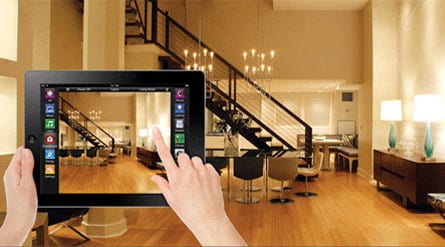
Photo - control of work with the tablet
Any lighting control will help provide a box like YaUO, which is used for manual and remote (from the remote control, from a computer or even a phone) control over electric lighting. Such a prefabricated contactor can be used in the apartment, but then it will be necessary to allocate space for the installation of the box. What are the technical characteristics of home nuclear weapons:
The main advantage of using a ready-made collection box is the ability to control LED, fluorescent and other types of lamps. It is also easy to install with your own hands.
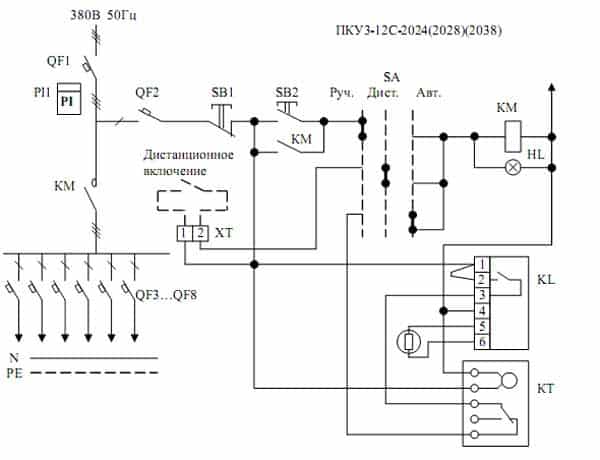
Photo - standard nuclear weapons
You can buy such a shield or ASUNO-GSM, AVR or PIC unit for controlling street or house lighting in special electrical stores. The price depends on the type of system and its capabilities, in principle, radio wave devices are more expensive than infrared. Before buying, it is advisable to develop a project for the location of groups of lamps, so it will be possible to choose a scheme for your own needs.

Photo - using ASUNO-GSM
Advantages of Wireless Control
Initially, touch control of lighting, for example, DALI, was used only with the concept of “Smart Home”, but now even in a rather mediocre apartment you can find a photo relay.
Automated lighting makes life easier for its owners. A 1-, 2- or even 5-channel shield will help from one point to control the lighting of the courtyard, corridors, bedroom hall and other rooms. Advantages of the system:
- Radio control increases the safety of the room. Lighting can be controlled not only from a personal stationary computer, but also using a telephone or even setting a timer. This will help protect your home from intrusion if you want to leave (offenders will not enter the house with the lights on);
- Saving consumables. A large amount of cable is required to pull the wires to the switches. In addition, its periodic will have to be changed in any case. Electronic control uses the minimum number of wires;
- You are not affected by power outages. A touch-sensitive cabinet and an automatic machine with switches are connected by radio waves; home and street lighting are controlled without connecting to a local circuit;
- Such an electrical control circuit is more convenient if you need to control lighting at two, three or more points. It can also be paired with a dimmer, providing in accordance with the location of these points a softer or, conversely, bright light.
The achievements of civilization are designed to make our life easier and more comfortable. Similar innovations touched our “fortress”. In recent years, conversations have been heard on every corner about equipping housing with technical equipment. Quite recently, such a concept as “smart home” has arisen, which includes a lot of mechanisms and systems. Remote control lighting has replaced the usual regulation of light.
More than 120 years there is electricity. However, despite such a venerable age, most houses are still lit to this day with lamps of the form of Thomas Edison. By the way, only 15% of consumed energy is converted into light, the remaining 85% take the form of heat. Therefore, it is safe to say that such systems are not economical and absolutely inefficient.
Benefits of Remote Control
Lighting systems, controlled exclusively in manual mode, have sunk into oblivion. The “smart home” system allows you to control lighting by installing remote control units for light with rheostats. Such schemes can remember a given level of brightness and turn on the light in a room.
The essence of the smart home system
Equipping houses with a system remote lighting provides their owners with undeniable advantages in comparison with a typical device of lighting equipment. For example, returning home, you will open the door to the hallway, which is flooded with light, and you do not need to fumble in the dark in search of a switch. Do not think, no one forgot to turn off the light when leaving.
The system of step-by-step switching is able to turn on the light ahead of human movement. You will walk through the lighted rooms, which is especially true if there are children in the house. This is the advantage of having intelligent lighting in a house that reacts to the appearance of people in the housing and to the movement of residents between rooms.
Depending on the sensors, the system elements of remote lighting are sensitive to any changes in the surrounding space. Availability remote control allows you to decide in which room and at what time the light will turn off and on. The fact that the light bulb is blown out, you will know directly by the fact.
But the main advantage of the intelligent lighting control system is dimmer lighting, which allows you to smoothly change the level of light and save energy. In the parameters of the system menu, you can pre-enter the specified scenarios, according to which the light will turn on.
Interior lighting control
Smart management Internal lighting in the house is carried out taking into account the day of the week and time of day. Such schemes are equipped with a real-time clock mechanism and are ideal for people who forget to turn off the lights in the room or bathroom, going to bed. The light level can be adjusted based on the presence of people in the room, remote lighting switches turn off or turn on the lighting in a particular room. In addition, such a function is aimed at significant energy savings.
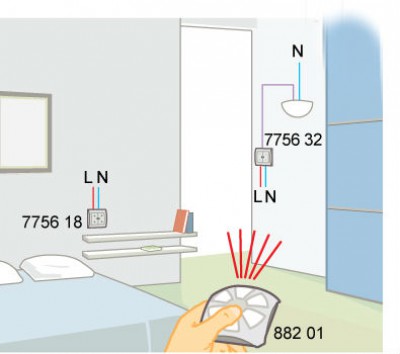
Outdoor lighting control
Intelligent lighting control systems also allow you to control outdoor lighting. Such systems include elements of auxiliary and garage lighting, as well as spotlights, which are controlled by remote controls or photosensitive sensors. Outdoor lighting, in addition to functionality, also carries a decorative component: the illumination of green areas, flower beds, artificial fountains and ponds. Control of street light from the controller of the "smart home" allows you to forget about the manual regulation of different lighting groups.
Lighting Scenarios: Variations
Light brightness in intellectual system Lighting can be adjusted depending on the background light scheme you have set. Options for light scenarios are quite diverse, they provide conditions for any everyday situations and events. Lighting scenarios can be programmed according to the wishes of the owner.
Classic lighting options:
- the “holiday” scenario involves the remote inclusion of lighting throughout the house, street lighting of the contours of the house, changing the color and intensity of the lamps;
- the scenario “evening garden lighting” implies lighting around the perimeter of the infield with various kinds of lamps, highlighting figures and trees, marking footpaths;
- the “romantic dinner” scenario consists in arranging dim lights in a room or in lighting a specific area of \u200b\u200ba house;
- the “anxiety” scenario lies in turning on the light throughout the house (“blinking light” option);
- the home cinema script organizes dimmed lighting in the living room while watching your favorite movies.

The classic scenario of remote lighting in the house: a romantic dinner with subdued light of a pleasant spectrum
During your absence, you can choose the scenario of light illumination of the gate, gate and the main elements of the house. Such illumination will become more intense with the onset of darkness. When you open the gate and the gate, the backlight of the gate, exit to the garage, paths and entrance doors will turn on, and when the entrance doors are opened, the interior lighting system of the house. Approaching decorative elements - a fountain, flowerbed, gazebo, located in the garden, includes their lighting. Thus, the “smart” light contributes to a significant comfort of a person in all life situations.
Electronic remote switches
The main advantage of remote switches is that during installation, no additional work is required. Even if an expensive renovation is made in the apartment, then drilling ceilings and walls, as well as buying and laying additional wires will not be needed. It will not be necessary to destroy what was created at the cost of incredible spiritual and material efforts.
Remote lighting switches of electronic type are divided into two large groups - radio-controlled and infrared. What are the advantages of these devices and the advantages over simple switches? Here you should remember how in the old days it was necessary to approach the TV and manually switch the channels. Perhaps the first devices that were equipped with remote controls, just were the TVs.
Later, VCRs and DVD players appeared that were equipped with such remote controls. But at the same time, to turn on the extra lamp, I had to go to the switch across the room. This situation prompted some companies to create sockets, dimmers and switches that are controlled by infrared rays.

Infrared remote switches provide the ability to command lighting within line of sight
A modern remote control lighting switch has one indisputable advantage: when controlling several different bulbs, it becomes possible to use one switch, instead of frantically looking for the right remote control to turn on each bulb.
The infrared remote control allows transmitting commands exclusively within the line of sight, thus, the signal transmission range is small - no more than 12 meters. Everything is determined by the power of the transmitter.
Remote Control Radio Switches
With all the advantages of infrared remote controls, they have one drawback - operating in the line of sight. Remote controls that operate on radio waves are deprived of this drawback. In this case, there is no clogging of the ether or radio hooliganism. Such smart lighting consoles allow you to control the remote load - that is, lighting devices that are located in the next room.
The transmitters operate in the frequency range that is reserved for these purposes - 433 or 868 megahertz, and their power is only 10 milliwatts, which is enough to work in a radius of 100 meters. It is such power that is regulated by law, so remotes of greater power are simply not available.
Various natural obstacles, for example, floors or walls, reduce the power of the radio signal, reducing the radius of the device. To compensate for power losses, radio signal repeaters are used. By the way, such equipment can be used in the "smart home" system or as an independent device for controlling any electrical equipment that is installed in the house.
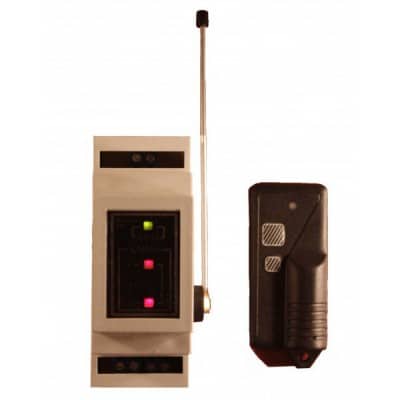
The radio remote control switch for lighting allows you to control the lighting, regardless of obstacles: concrete, brick walls, significant distances, etc.
Remote switches consist of at least two parts - an actuator and a control panel. Sometimes it may be necessary to install additional devices - signal repeaters, in the event that the radio signal is significantly weakened, in particular from reinforcement in reinforced concrete structures.
Radio switches are produced in the form of adapters, which are simply inserted into existing sockets and controlled by remote controls that are included with the equipment. No matter how funny it sounds, but the device is often remembered last.
Thus, the remote lighting control system can be configured to synchronize with a change in the real time of the day. It is enough to program by timer the number and intensity of the lamps. The remote lighting system will operate according to a user-defined scenario. In addition, such control of the brightness of the light in the house can significantly save energy costs.
- Saving. Since the lighting of the space occurs only when it is necessary, as a result, the saving of payment for electricity is up to 50%. The payback period for the installation of equipment and the cost of electricity is paid within 6 months.
- Convenience. No need to look for a switch in the dark. The automatic light switch will relieve you of worries about the light forgotten by the included light. You can set the light on and off as you wish.
- Security. The automatic lighting control system eliminates the appearance of unexpected obstacles in your way. For example, if you walk along the street or ride a bicycle - because of the lights turned off or burned out, you did not see a cobblestone in front, the result is abrasions on your hands, feet and a spoiled mood. Or your hands are busy, and you go into an unlit room - to stumble over the threshold will be very painful and offensive.
- Detection of unwanted guests -automatic lighting not only informs you about the appearance of an uninvited guest, but can also scare him away. Since he has already been seen, this may affect his intentions.
What blocks can an automatic lighting control system consist of:
- Motion Sensor. Automatic lighting control systemequipped with such a sensitive element turns on the light when a person appears in the sensitivity zone of the sensor and turns off some time after the person leaves it or does not show activity.
- Volume sensor. It acts in a similar way, but does not turn off if a person is stationary. It is used both to turn on / off the light, and for other electrical appliances.
- Presence sensor. It keeps the light on as long as the person is in the sensitivity zone of the element. The device picks up even minor movements such as nodding your head or swaying your legs.
- Remote control. Depending on the complexity of the remote control, an impact is made on a group of devices. For example, main lighting, auxiliary, decorative. In addition, you can change the light intensity.
Sensors can be microwave or infrared, the latter more common. The range of sensors varies - usually it is 8, 12 and 20 meters, the coverage area is 180 or 360 degrees. They can be built-in and external, some models are made in a moisture-proof case.
Automatic lighting is applicable in rooms of any purpose, you just need to decide on the type of control. So, for living rooms, bedrooms and children's rooms, systems that can be controlled remotely by the remote control are preferable. This will allow you to adjust the level of illumination, turning off unnecessary devices. Special purpose premises - toilet rooms, corridors, basements, garages - it is better to equip with sensors of movement, volume or presence. For outdoor lighting, streetlights with a light sensor are good, turning on the light when dusk sets in and turning it off as soon as the street is sufficiently dawn. Manual control of street lighting devices by remote control is possible.
In one lighting control system, you can combine a variety of lighting devices, each of which will be configured as necessary.
Safe-Video online store is an excellent choice for those buyers who were looking for where to buy motion sensors, volume sensors, presence sensors, light sensors, light fixtures with sensors and other products of automatic lighting.
Remote lighting control is invented for the convenience of users. For example, approaching the gates of a house, you can turn on the house lights with the touch of a button, without leaving the salon. Using the remote control, without getting out of bed, you can turn on, off, adjust the brightness and direction of light.
All these seemingly insignificant functions separately form the level of comfort of human life. This article will focus on light control systems, lighting fixtures, and varieties of communication signals between equipment.
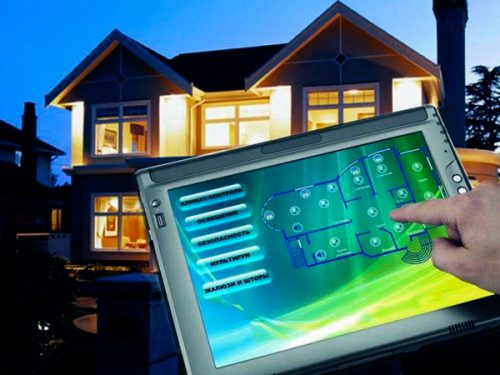
Advantages of Remote Control
Initially, remote control over lighting was used only in expensive “smart home” systems. However, gradually this function became available even on the photocell.
In addition to general comfort, the following advantages of remote control can be noted:
- Remote control increases room safety. Since you can control the system using a computer or smartphone, it is possible, for example, to create the effect of being in the apartment, turning on the lights there in the evenings.
- The lack of need for wires means significant savings on the purchase of consumables and installation work. In addition, do not forget that in wired systems, sooner or later, you need to replace the cable.
- There is no dependence on emergency power outages if the cabinet, circuit breaker and touch switch with the remote control are connected via radio waves, and the lighting is controlled outside the local circuit.
- Such an electrical circuit is especially comfortable if you need to control lighting devices at many points at once.
Lighting Management Organization
Lighting devices are controlled by various methods. For example, you can control the lighting with just one controller, located in the most convenient place in the room. You can also arrange control from a remote control. The remote control can be shared between several rooms or in each room there will be a separate remote control.
The most advanced way to control the light is the “smart home” system, where all the lighting points are combined into one. In "smart homes" provides programmable algorithms for the system, as well as motion sensors.
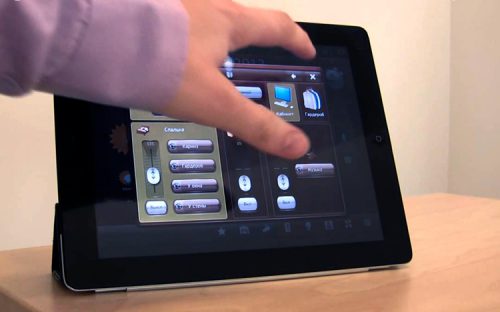
In large office buildings, mansions and industrial premises, management is often carried out with a group board. Moreover, centralized management may not necessarily be carried out by means of a knife switch on a common shield. A separate controller can be used to turn on and off the light. Centralized management includes some remote methods. It's about managing from a computer or mobile phone. These control methods will be described in more detail below.
In standard sized housing, it is also possible to install a common controller. This is a very convenient device that allows you to turn off or turn on the light (in one or more rooms) in one motion, without departing from the threshold of the apartment.
The most popular remote control lighting. You can adjust the lighting anywhere in the house: at fountains, streetlights, utility rooms, lawns, etc. Remote control of light can be carried out by various means. The most common way is using the remote control.
The use of remote control in an apartment is not always justified, since the use of this device is still associated with moving around the premises. Of course, remote control is convenient if you need to turn off the light in the kitchen from the living room. But what if the owner of forgetfulness left the remote control in the kitchen? A lot of misunderstandings can arise in situations when several residents at once want to control lighting devices in the apartment. The use of remote control of light in the bathroom and toilet is also doubtful.
Wireless control will be very useful in rooms where there is multi-tiered lighting, implying the presence of several types of lighting devices: chandeliers, decorative, wall or ceiling LED lamps, sconces, etc. In this case remote system really will be in place and will increase the comfort of living in the house.
Automatic lighting control system
By automatic devices are meant motion sensors, photovoltaic cells, timers, etc. For example, by installing sensors in the kitchen and in the bathroom, you can no longer worry about forgetting to press the switch. After a specified time (for example, a minute) after leaving the room, the light will turn off automatically. Sensors are also very convenient for families with small children who, due to their short stature, cannot reach the switches.
Varieties of control systems
Several types of devices are used to control lighting:
- infrared;
- impulse;
- radio waves.
Infrared devices are widely used in outdoor lighting systems, as well as on landings and in public corridors. with a remote control on IR elements works on the same principle as a conventional remote control for a TV. Such devices are not difficult, but they also have disadvantages.
For example, infrared elements retain functionality only with the direct visibility of the lighting device and at a limited distance (up to 10 meters). Such restrictions cause inconvenience, since the ability to remotely control becomes incomplete.
Recently, the problem has been solved by special amplifiers that amplify the infrared signal. The amplifier works according to the following principle: the received infrared signal is converted into a radio wave, in which the propagation possibilities are much higher.
Control via a radio channel is carried out by sending a signal from the remote control to the controller. The advantage of the technology is the absence of restrictions on the visibility of the lighting device. However, such devices have a drawback - a considerable cost.
A common option for signal transmission is the use of a pulse relay. The device is installed in a panel or directly in the switch. This is the best option for large buildings in which there are many vestibules and stairwells, since almost all modern models are produced with a timer.
Lighting Control Devices
Lighting control is carried out using a variety of devices. Some of them relate to the main ones, the other part to the auxiliary ones. More details about these elements will be described below.
Lighting control unit
This device is used for remote control of lighting fixtures. Management is carried out by pressing the appropriate buttons, which start the forced on or off lighting points, and also control other functions (for example, light intensity).
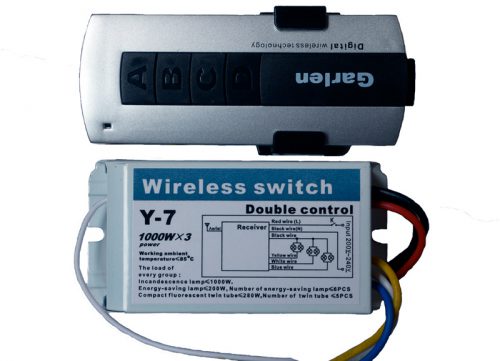
Some units are able to control the group through a conventional remote control for a TV or other household appliances. The buttons on the unit are universal, they can be programmed for the desired functions.
Control controller
The most technically simplest remote control option is the wall controller. Leaving or coming into the house, you can remotely turn on or off the lighting devices.
The device is an automatic machine that controls lighting devices in accordance with the algorithm laid down in the program. Information on the controller comes from the remote control, from sensors or buttons in manual mode. You can program the controller yourself, using the keyboard and LCD display.
Sensors
Circuits often contain motion sensors whose pyrosensors respond to heat emanating from a human or animal body. After receiving the signal, the device is triggered: when someone enters the room, the light turns on, when no one is in the room, the light goes out.
The sensors work precisely, since infrared radiation only works when there are no barriers in the form of walls. In other words, false alarms of the sensor are excluded when someone is in the next room. Some equipment modifications use ultrasonic indicators to increase recognition efficiency.
Photovoltaic cells allow you to control the brightness of the lighting. The intensity of artificial light is determined by the overall illumination of a room or outdoor space. For example, lawn lighting or streetlights can turn on automatically when it is really necessary, i.e. with the onset of the evening. Turning off such lighting also occurs automatically as soon as it becomes light outside.
Remote Control Switches
A switch with a remote control is most often designed according to the principle of response to infrared rays. Moreover, the beam must be sent directly to the infrared receiver.
Radio-controlled switches can receive signals at a distance of up to 100 meters, regardless of obstacles. With increasing distance, the signal quality decreases, but still remains at an acceptable level. It is also worth noting that the radio-controlled devices operate at dedicated frequencies (433 and 868 MHz), which eliminates the clogging of the ether.
Remote Control
Externally, such a device is similar to a conventional remote control from a TV or air conditioning. Moreover, in some cases, the television remote control is used to control the light (for this you need to reprogram it). In “smart home” systems, with one remote control, you can control all the electronic devices in the building.
In the standard version, the IR remote control is equipped with 5-7 buttons, each of which has its own functional purpose. Each button can have from one to two hundred devices.
Radio remote controls feature enhanced functionality. Usually there are 7-9 buttons on them that correspond to different lighting groups. In addition, each group has its own address. After pressing the button, the signal is received by all groups, but the response comes only from the specified address.
In addition to a fully functional remote control, a small key fob can be included in the system package, which can be used to control the minimum necessary set of commands. For example, using such a key fob, you can open the garage door by turning the light in the garage and the front door of the house on or off.
Lighting control is also possible using the software installed on the computer. Moreover, to control the lighting devices it is not necessary to be at home, since all commands can be transmitted over the Internet. After entering the login and password, the user enters the system where the commands are transferred to the house through an intermediate server.
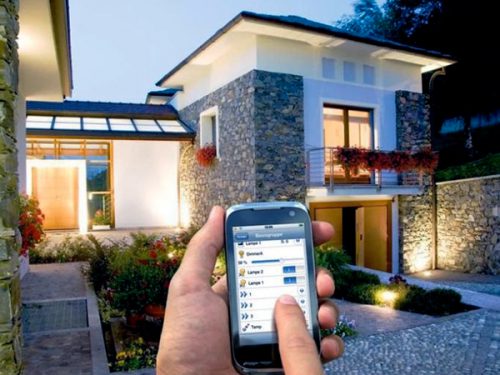
You can control the lighting with your smartphone. To do this, you need to install a special program on the phone. If desired, you can send encoded SMS to your home system. The control principle from the smartphone is the same as with a computer. The only limitation is the slightly lower functionality of a smartphone compared to a computer.
Photocells
Photovoltaic cells are installed in dark places where they will not be illuminated by lamps. Compliance with this condition will avoid false positives. Photocells do not respond to short-term flashes of light (lightning, headlights on the street). The device responds only to the general level of illumination.
Timers and relays
The timer is used to schedule the time on or off lighting. For example, the light in the house can be turned on a few minutes before the tenants arrive home. In the same way, for a given time, the inclusion and deactivation of light in the territory adjacent to the house is programmed.
The time relay is used in cases where you need to control the lighting according to a predetermined schedule. As an illustration, we can cite a situation when there is a need to turn on the light at a certain time, and then turn it off. Inside the device there is a processor that is able to set the time of sunrise and sunset, as well as calculate the right time.
A remote testing and emergency lighting control device called “TELEMANDO” provides remote monitoring and control in emergency situations. Monitoring refers to the inclusion of emergency mode in order to test the operability of lighting devices, as well as troubleshooting if necessary.

The control consists in turning off the emergency mode (for example, when the main lighting is turned off, during repairs, etc.) in order to save battery power in emergency lighting devices.
The choice of specific equipment for remote control of lighting devices depends on many factors (building size, number of lighting devices and the nature of their placement). Not the last role is played by the financial capabilities of the buyer. Before buying equipment, it is recommended that you consult with a sales assistant.


